-

人教版高中英语必修3Healthy Eating说课稿4篇
Language learning needs a context, which can help the learners to understand the language and then can product comprehensible output, so computer has the advantages to make the materials attractive.Part 3 Learning MethodsTask-based, self-dependent and cooperative learningPart 4 Teaching ProcedureStep One Lead-in“Interest is the best teacher.” Therefore, at the very beginning of the class, I should spark the students’ mind to focus on the centre topic “the band”. I’ll show some pictures of food to attract their attention and then bring some questions.Question:What kind of food they like?What should go into a good meal?The answers must relate to the diet. After this, the students will be eager to know something about a balance diet and this is the very time to naturally lead the class into Step 2Step 2 Reading for information: skimming and scanning In this step, I use Task-based Language Teaching method, which can give students a clear and specific purpose while skimming and scanning the context.Task 1 General ideaThe students will be asked to just glance at the title and the pictures of the passage, and then guess what they will read in the text. And they’ll be divided into groups of four to have a discussion.The purpose is to inspire the students to read actively, not passively. In addition, the task is to develop the students’ reading skill by making prediction and to encourage the students to express their thoughts in English and cooperate with each other.Task 2 Main idea of each paragraphCooperative learning can raise the students’ interest and create an atmosphere of achievement. Based on this theory, I divide the whole class into 4 groups to skim the whole text and get the main idea of each paragraph.

人教版高中英语必修4Working The Land说课稿3篇
Knowledge objectives:(1) to make Ss grasp the usage of words, expressions and sentence structures: statistics, struggle, thanks to, rid of, some patterns for persuasion, the “ing” form as subject and object;(2)to use learnt knowledge to persuade sb.Ability objectives:(1) to develop Ss’ reading skills(skimming, scanning, word guessing);(2) to improve Ss’ speaking, communicating and cooperating skills.Emotional objectives:to make Ss know the contribution of Yuan,and learn his spirit and his simple life time.Teaching important and difficult points:(1) some words, expressions and sentence structures mentioned above;(2)the content of the text;(3)training their reading and speaking skills.Teaching methods: CLT, TBLT,QT.Learning strategies: CLS, QLS, TBLS.Teaching procedures:Step 1 lead-in: (1) teacher plays a piece of recent news from CCTV about the harvest of the super hybrid rice, and ask students whether they know Yuan or not, and talk about him and his contribution.(2)Brain storm: let Ss describe Yuan in their minds including his appearance, his living condition and so on.Step 2 fast reading tasks:(1)teacher introduces Yuan and super hybrid rice(2)make Ss read the text as fast as possible with questions. Such as: what’s the general ideaof this passage? What’s Yuan’ dream? (skimming and scanning skill)Step 3 intensive reading tasks(1)let Ss read the text silently, find topic sentence of each paragraph and draw the difficult sentences and the knowledge what they don’t understand.(words guessing)(2)teacher and Ss talk about the important words, expressions and sentences together, and ask Ss to retell the content of the text.(summarizing and paraphrasing)(3)teacher summarize this part.(4) read again following the courseware.

人教版高中英语必修3The million pound bank note说课稿3篇
在接下来的细读环节,我套用了高考对阅读理解的考查方式设置了5个问题,分别为三个推理判断题,一个细节题和一个主旨大意题。学生需要对文章的内容进行分析、归纳、推理、猜测等高级思维活动才能做出正确的回答。【设计意图】这一过程是对学生进行细读的训练,培养学生获取特定信息和挖掘文章深层次信息的能力。第三环节:Intensive-reading (精读) 15′第三个环节精读,既是最重要的环节,也是突破本课重难点的关键。首先,让学生思考剧本中人物看到百万英镑前后的态度发生了怎样的变化。其次,让学生仔细阅读文章,找出可以表现人物态度变化的具体的语言和动作。最后,让学生总结人物的态度发生变化的根本原因是什么,从而引出Money Talks, 供学生思考。【设计意图】通过一系列的活动培养学生学习从人物的语言和动作探究人物的心理,使学生进一步体会戏剧语言的魅力,从而对文章背后所反映的社会问题进行思考,也为下一步的讨论环节做好铺垫。

人教版高中英语必修5First aid说课稿6篇
In this class, I have 3 teaching aims, that is, knowledge aims, ability aims and emotion aims.1) Knowledge-Teach students new words and expressions, such as temporary, bleed,sprain choke, first aid, fall ill and so on.-Enable students to have a better understanding for some basic knowledge of first aid.2) Ability-Train students’ speaking, reading and writing abilities by different teaching activities, such as skimming, comprehending, team work, role play, retelling and writing.-Develop students’ reading strategy on how to move general idea to specific information.3) Emotion-Promote students’ awareness of giving first aid.- Cultivate students’ creativities.Then let’s come to my teaching methods and activities.III. Teaching methods and activities:To achieve different teaching aims, various kinds of teaching methods and activities will be adopted throughout this period, such as TBL (task-based learning), skimming, team work, brainstorm and others, which can offer students opportunities to fulfill tasks in which they can use language to achieve a specific outcome.IV. Teaching aids:Computer and blackboardV. Teaching important points:1) Make students have a clear mind for the structure of the text.2) Help students understand the theme of the text.VI. Teaching difficulties:1) So many new words may affect students’ understanding.2) How to get students to know about the functions of the skin and thecauses, characteristics and treatments for different degree burns,and the knowledge about giving first aid. VII. Blackboard design:

人教版高中英语必修5Great scientists说课稿4篇
通过写文章梗概,培养学生综合运用语言的能力,学习用恰当的英语描述科学家的故事。这是本课的教学难点。教师可以使用完形填空的方式来帮助学生整理语篇,从而来降低难度。本课的教学重点的突破方法是:在阅读前,让学生初步了解得出科学观点所需要的基本程序,从而轻松而自然地导入文章的阅读;在阅读过程中,由易到难设计快速阅读和精读的问题,层层推进各种阅读活动,让学生对阅读内容从整体感知到细节理解,最后深层读懂整篇文章,同时加强阅读策略的指导,让每个学生都主动参与课堂教学活动,最终达到提高阅读能力的目的。Step 4 Post-readingGroup Activities四人小组共同合作,在老师的适当指导下,就以下2个问题展开讨论,让学生就所知、所学、所感和所想融入话题,然后抽若干同学代表作小组发言。1. What do you think about John Snow, and what should we learn from him?2. Cholera was 19th century disease, which two diseases are similar to cholera today? Why?

人教版高中英语必修5Life in the Future说课稿5篇
Good afternoon, everyone. It’s my great pleasure to be here sharing my lesson with you. The content of my lesson is Senior English for China Book5 Unit 3 Life in the Future. I’ll be ready to begin this lesson from six parts: Analysis of the teaching material, Analysis of the students, Teaching aims and important and difficult points, Teaching methods and aids, Teaching procedures, and Blackboard design. First, let me talk about the teaching material.Part 1 Analysis of the Teaching Material:This unit is about what human beings’ life will be like in about one thousand years. By studying of this unit, we’ll Enable the students to know the changes in humans’ life and some new inventions bringing about the change and develop the interest in science. This lesson plays an important part in the English teaching in this unit. This is an important lesson in Book Five. From this lesson, it starts asking the Ss to grasp contents of each passage. Therefore, this lesson is in the important position of the teaching material. If the Ss can learn it well, it will be helpful to make the Ss learn the rest of this unit.Part 2 Analysis of the SsAs Senior2 Ss, they are at different levels of English fluency, some of them have lost interest in English. So during the lesson, I arrange a variety of activities to let all of them join in to attract their interest and let them be confident and taste the joy of success.

人教版高中英语必修5Making the news说课稿4篇
今天我们来介绍一下必修五第四单元的授课方式。这个单元的题目是Making the news。应该是学生比较感兴趣的话题,学生往往对新闻工作充满好奇,所以我们可以利用这个机会多设计一些师生互动和学生互动,来激发起学习的积极性,提高学习效率。同时我们可以利用这个单元不仅帮助学生掌握语言知识,培养语言能力,同时让其了解新闻工作的重要性,培养起社会智能感。这个单元分为六个课时,它的教学目标是这样的:语言目标是掌握词汇表中的常用单词和短语,掌握倒装句的一些基本用法。 技能目标是能初步掌握约会的基本句型并在真实的场景下正确运用。新闻报道类文章的写作技能。采访的基本规范和沟通技能。情感目标是对新闻报道的客观性和真实性有更好的理解。对新闻记者的职业有更深入的了解,并能体会其工作的重要性。下面我们来介绍一下第一课时的授课方式,第一课的教学目标是这样的第一课时的教学目标语言目标:单词:Occupation, journalist, editor, photographer, curious, personality, enthusiasm

人教版高中英语必修5The United Kingdom说课稿4篇
Teaching Aims:Knowledge 1. Get the students to learn the useful new words and expressions in this section. Aims:2. Let the students learn about how the UK was formed and the four groups of invaders.1. Develop students’ reading ability and let them learn different Ability reading skills. Aims:2. Enable students to learn to talk about the United Kingdom and the Union Jack Emotional 1. Let students know more about the UK2. Develop students’ sense of cooperative learning Aims:Teaching Important Points:1. Let the students learn about the countries of the United Kingdom and the Union Jack2. Get the students to read the passage and know about how the UK was formed and the four groups of invaders.3. Have the students learn different reading skills.Teaching Difficult Ponts:1. Develop students’ reading ability.2. Enable students to talk about the United Kingdom and the Union Jack.3. Let students learn how the UK was formed geographically and historically.Teaching Methods:Showing pictures, asking, exercising, listening, reading etc.Teaching Aids:A computer,a projector and a blackboard.Teaching Procedures: 1) Show a map of the world, ask students the following questions:Where is the UK?What’s the full name of the UK?2) Ask the students work in pairs to do the quiz on Page 9.Do you want to test how many things you know about the United Kingdom? Let’s have a small test.Using the map on P9, students answer the following questions:?How many countries does the UK consist of? What are they??England is divided into three main areas. Do you know what they are? 1) Scanning (10Minutes )Let the students hold the questions asked in pre-reading and read the passagequickly and then let them do the following exercise.Join lines to the right answer.
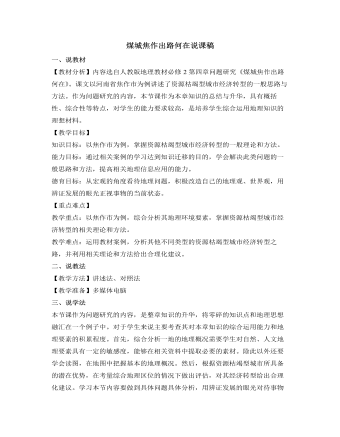
人教版高中地理必修2煤城焦作出路何在说课稿
分析过焦作市的地理概况和产业优势后,就需要针对由于资源枯竭所带来的问题提出合理化的建议。既然是谈经济转型,就应该将话题的范围明确在这一领域内。通过材料3的相关内容,我们了解到焦作市需要在产业结构调整、培育新的优势产业、增强综合竞争力等三个整改方针上下功夫。因而引导学生针对优势与不足提出建议,以三个整改方针为基准,衡量建议的可行性是锻炼学生解决此类问题的有效途径。在此我将教会学生的是解决问题方法而非案例的内容,正所谓“授之以鱼,不如授之以渔”。接下来针对学生的建议和教材资料分析所罗列的10点整改思路,由学生自由发言提出看法,通过教师的指导和学生的讨论,进而确定经济转型建议的具体方案。最后注意将建议与产业优势相对照,看建议是否都是围绕着产业优势而提出的,这样做会加深学生的印象,通过建议和优势的对应关系,将不难找出此类问题的解题思路。
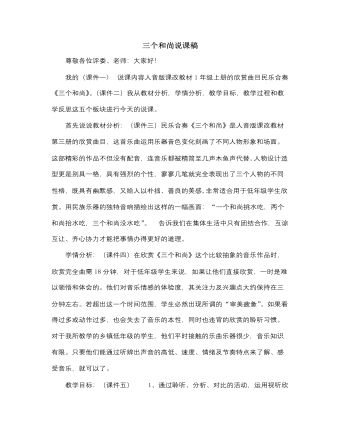
人音版小学音乐一年级上三个和尚说课稿
3.请几组同学表演这几个的场面,其他同学做评委,从模仿表演中享受学习音乐的快乐。五.课堂小结 (阶段目标:以“我的收获”(课件十)帮助学生总结所学内容,知道音乐中,不同的音乐要素可以表现不同的人物、场面)课后反思:(课件十一)在本节音乐欣赏教学中,我坚持以“听”为核心(因为音乐是一门听觉艺术),让学生“带着问题听”、“想着听”、“动着听”、“演着听”等多元化的“听”的形式。一系列“听”的任务不仅提高学生的注意力,而且提高学生“听”的兴趣与“听”的质量。而且我创造和谐的课堂气氛,积极引导学生把对音乐的内心感受大胆地用语言表达出来,让学生主动参与音乐快乐学习的实践中去,创建出有利于学生发展的生动活泼的音乐课堂情景,让学生的了解音乐,感受音乐,融入音乐。
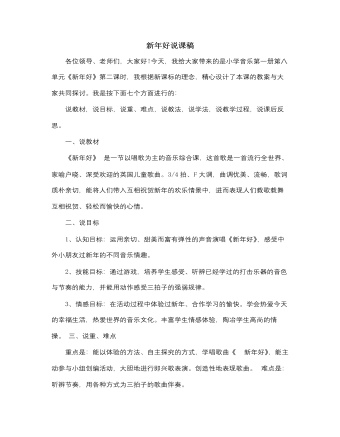
人音版小学音乐一年级上新年好说课稿
一、说教材《新年好》 是一节以唱歌为主的音乐综合课,这首歌是一首流行全世界、家喻户晓、深受欢迎的英国儿童歌曲。3/4拍、F大调,曲调优美、流畅,歌词质朴亲切,能将人们带入互相祝贺新年的欢乐情景中,进而表现人们载歌载舞互相祝贺、轻松而愉快的心情。二、说目标1、认知目标:运用亲切、甜美而富有弹性的声音演唱《新年好》,感受中外小朋友过新年的不同音乐情趣。2、技能目标:通过游戏,培养学生感受、听辨已经学过的打击乐器的音色与节奏的能力,并能用动作感受三拍子的强弱规律。3、情感目标:在活动过程中体验过新年、合作学习的愉快。学会热爱今天的幸福生活,热爱世界的音乐文化。丰富学生情感体验,陶冶学生高尚的情操。 三、说重、难点重点是:能以体验的方法、自主探究的方式,学唱歌曲《 新年好》,能主动参与小组创编活动,大胆地进行即兴歌表演。创造性地表现歌曲。 难点是:听辨节奏,用各种方式为三拍子的歌曲伴奏。
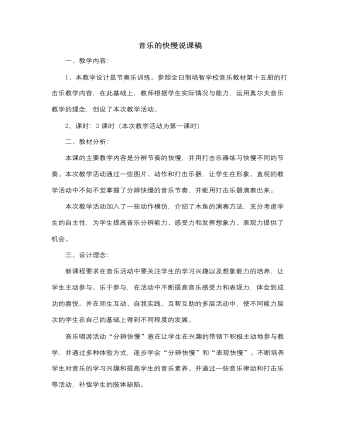
人音版小学音乐一年级下音乐的快慢说课稿
3、用木鱼来演奏音乐的不同节奏。(1)师:小动物们都能听着音乐按节奏走路了,下面我想考考你们能不能用这种乐器来演奏不同的节奏呢。(2) 出示木鱼,演示木鱼的演奏方法。师:左手拿木鱼,右手拿木棍,敲的时候要注意不要打在自己的手指上,打在手指上是没有声音的。(3) 玩游戏《听一听》,训练学生的听辨能力和记忆能力。师:我们先来玩一个游戏,老师敲出几个不同的节奏,你们听听哪个是最慢的,哪个是最快的,看谁的耳朵最灵敏。(4) 学生练习演奏木鱼,学会用木鱼敲出不同的节奏,教师个别指导。师:现在就请同学们自己来演奏木鱼,你可以尝试着怎样敲会快一点,怎样会慢一点。(木鱼学生人手一个)[设计思路]在分层教学过程中,由于个别学生的基础比较差,第一和第二段音乐的演奏训练还不能完全掌握,所以花的时间比较长。导致接下的第三和第四段音乐的木鱼节奏训练没有时间完成。我将在第二课时的复习巩固课上再让同学们来练习演奏。
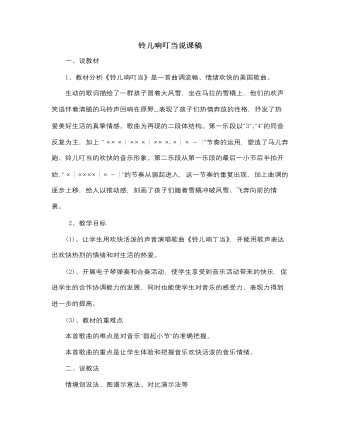
人音版小学音乐五年级下册铃儿响叮当说课稿
结合我们学校的教学条件和我自身会弹琴的优势,我还设计了课堂弹奏活动,激励学生练习好了参加圣诞联欢晚会给大家表演节目。 我把第一段的乐谱进行了简化节奏让学生弹奏,在弹奏基本完成后还设计了学生边唱边弹,并且分组让学生用电子琴自带的的打击乐器进行合奏练习,让学生在学唱的同时更加深入的体会音乐欢快活泼的节奏特点,同时让学生感受合奏的整体的音响效果,培养了学生的动手能力和集体合作能力。 六、总结 本课以歌曲《铃儿响叮当》为主要内容,听、唱、弹等教学环节都围绕他展开,各教学环节的设计易于统一,各项活动的设计均以音乐审美为核心,教学中关注段落的划分,注重引导学生的参与,体验,引导学生积极探索创造学习,展现音乐的节奏之美。
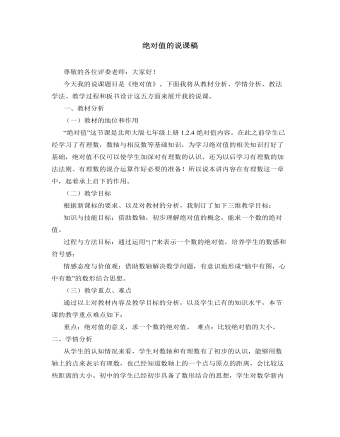
北师大初中数学七年级上册绝对值的说课稿
(三)学以致用,巩固新知为巩固本节的教学重点我再次给出三道问题: 1)绝对值是7的数有几个?各是什么?有没有绝对值是-2的数?2)绝对值是0的数有几个?各是什么? 3)绝对值小于3的整数一共有多少个?先让学生通过小组讨论得出结果,通过以上练习使学生在掌握知识的基础上达到灵活运用,形成一定的能力。(四)总结归纳,知识升华小结时我也将充分发挥学生学习的主动性,发挥教师在教学的启发引导作用,和学生一起合作把本节课所学的内容做一个小结。(五)布置作业,拓展新知布置作业不是目的,目的是使学生能够更好地掌握并运用本节课的内容。所以我会布置这样一个作业:请学生回家在父母的帮助下,找出南方和北方各三个城市的温度,并比较这些温度的大小,并写出每个温度的绝对值进行比较
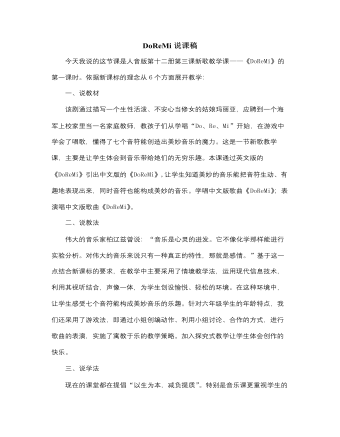
人音版小学音乐六年级下册DoReMi说课稿
1.通过欣赏《DO RE Mi》的影片,调动学生的积极性,增强学生学习新歌的兴趣。2.了解电影。任何一首歌曲都有着不一样的故事,通过文字简介,能够帮助学生深入歌曲的学习,升华表演的情绪。然后通过聆听歌曲《DO RE MI》,师范唱,生听唱,师指导唱的形式来帮助学生继续领略音乐的魅力。7.音乐游戏。不仅将学生分成七个小组跟琴演唱,还让学生根据伴奏完成歌曲接龙,充分体现了学生在课堂中的主体性。8.拓展开发。通过了解柯尔文手势,电影的背景资料和歌曲《孤独的牧羊人》的欣赏,提高学生的能力。第二环节既是这节课的重点,也是难点,通过引导学生运用手势音阶和肢体语言来表演歌曲《DoReMi》,又通过小组合作的方式突破难点。最后小结,简单地总结了同学们的表演让所有人感受到音乐带给我们的无穷乐趣,七个音乐字母构成了美妙的音乐,最后在美妙的音乐中结束了这节课!
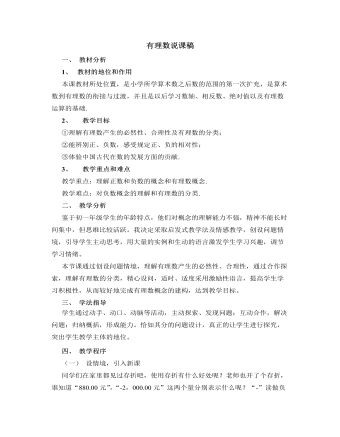
北师大初中数学七年级上册有理数说课稿
1、 教材的地位和作用本课教材所处位置,是小学所学算术数之后数的范围的第一次扩充,是算术数到有理数的衔接与过渡,并且是以后学习数轴、相反数、绝对值以及有理数运算的基础.2、 教学目标①理解有理数产生的必然性、合理性及有理数的分类;②能辨别正、负数,感受规定正、负的相对性;③体验中国古代在数的发展方面的贡献.3、 教学重点和难点教学重点:理解正数和负数的概念和有理数概念.教学难点:对负数概念的理解和有理数的分类.二、 教学分析鉴于初一年级学生的年龄特点,他们对概念的理解能力不强,精神不能长时间集中,但思维比较活跃。我决定采取启发式教学法及情感教学,创设问题情境,引导学生主动思考,用大量的实例和生动的语言激发学生学习兴趣,调节学习情绪。
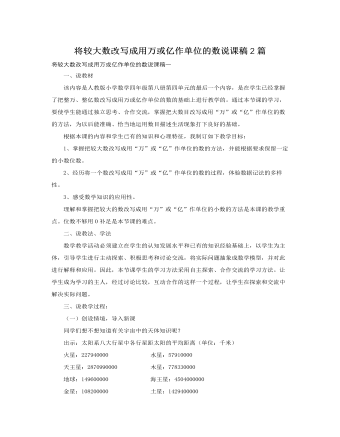
人教版新课标小学数学四年级下册将较大数改写成用万或亿作单位的数说课稿2篇
一、说教材该内容是人教版小学数学四年级第八册第四单元的最后一个内容,是在学生已经掌握了把整万、整亿数改写成用万或亿作单位的数的基础上进行教学的。通过本节课的学习,要使学生能通过独立思考、合作交流,掌握把大数目改写成用“万”或“亿”作单位的数的方法,为以后能准确、恰当地运用数目描述生活现象打下良好的基础。根据本课的内容和学生已有的知识和心理特征,我制订如下教学目标:1、掌握把较大数改写成用“万”或“亿”作单位的数的方法,并能根据要求保留一定的小数位数。2、经历将一个数改写成用“万”或“亿”作单位的数的过程,体验数据记法的多样性。3、感受数学知识的应用性。理解和掌握把较大的数改写成用“万”或“亿”作单位的小数的方法是本课的教学重点。位数不够用0补足是本节课的难点。
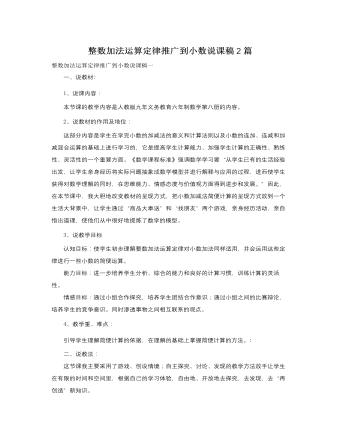
人教版新课标小学数学四年级下册整数加法运算定律推广到小数说课稿2篇
1.揭示课题那么,这个运算定律是否对分数加法也适用呢?现在我们就来研究这个问题。板书课题:整数加法运算定律推广到分数加法。2.研究运算定律对分数加法的适用性出示式题:提问:上面每组算式的左右两边有什么关系?得数是否相等?先指名学生练习,算出得数后,再引导学生观察。提问:这两组试题有何共同之处?组织学生开展小组讨论,共同概括总结出他们的共同点,得出规律性的认识,从而使学生体会到整数加法运算定律,对分数加法同样适用。通过讨论明确:加法的交换律、结合律中的数,既包括了整数,又包括了小数和分数。【设计意图】通过具体的实践活动,直观感知了加法运算定律同样也适用于分数加法。这种通过自己实践得来的东西,学生理解得更透,掌握得更牢。

古诗词诵读《拟行路难(其四)》说课稿 2021-2022学年统编版高中语文选择性必修下册
(一)导入新课“时势造英雄”,恶劣的环境造就名诗名篇。正因如此,怀才不遇于古人是恒久的情感素材。同学们,请大家回忆我们学过哪些抒发作者怀才不遇的诗词?(二)解释题意拟:仿照,模拟《行路难》,是乐府杂曲,本为汉代歌谣,晋人袁山松改变其音调,创制新词,流行一时。 鲍照《拟行路难》共十八首,歌咏人世的种种忧虑,寄寓悲愤,今天我们学习的是其中第四首。(三)作者简介、写作背景门阀制度之下,“上品无寒门,下品无世族”,出身寒微的文人往往空怀一腔热忱,却报国无门,不得不在壮志未酬的遗恨中坐视时光流逝。即使跻身仕途,也多是充当幕僚、府掾,备受压抑,在困顿坎坷中徒然挣扎,只落得身心交瘁。
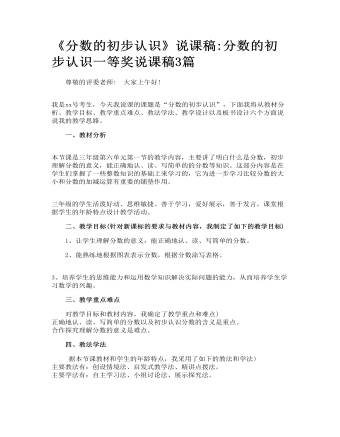
《分数的初步认识》说课稿_分数的初步认识一等奖说课稿3篇
一、教材分析? 本节课是三年级第六单元第一节的教学内容,主要讲了明白什么是分数,初步理解分数的意义,能正确地认、读、写简单的的分数等知识。这部分内容是在学生们掌握了一些整数知识的基础上来学习的,它为进一步学习比较分数的大小和分数的加减运算有重要的铺垫作用。? 三年级的学生活泼好动、思维敏捷、善于学习,爱好展示,善于发言,课堂根据学生的年龄特点设计教学活动。 二、教学目标(针对新课标的要求与教材内容,我制定了如下的教学目标)????? 1、让学生理解分数的意义,能正确地认、读、写简单的分数。????? 2、能熟练地根据图表表示分数,根据分数涂写表格。? 3、培养学生的思维能力和运用数学知识解决实际问题的能力,从而培养学生学习数学的兴趣。????? 三、教学重点难点 对教学目标和教材内容,我确定了教学重点和难点)???正确地认、读、写简单的分数以及初步认识分数的含义是重点。???合作探究理解分数的意义是难点。

